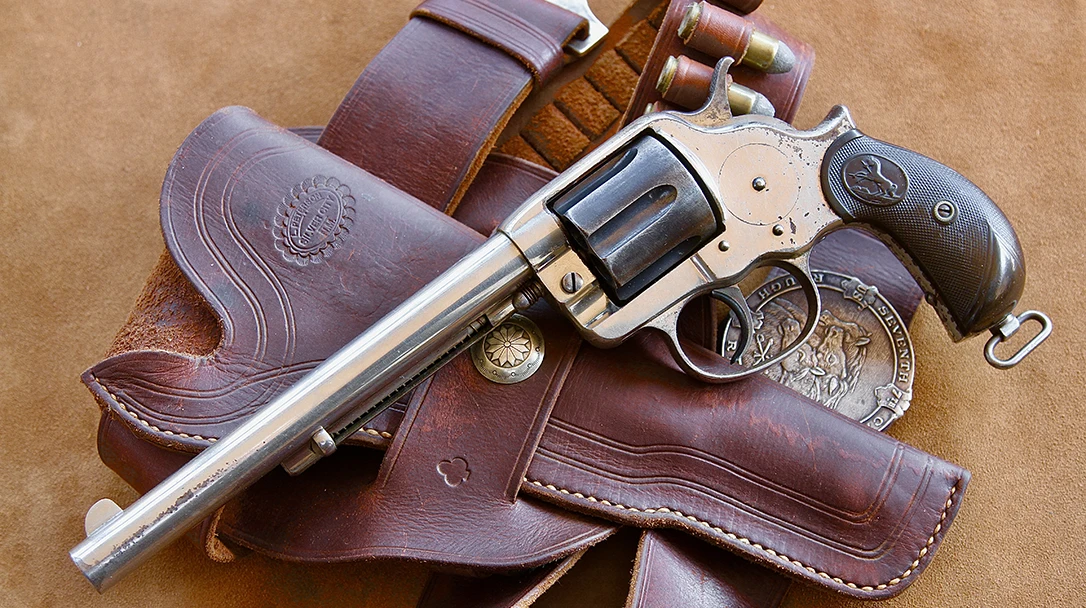Although Samuel Colt had disdain for the double-action revolver, by 1873, Colt’s Vice President General William B. Franklin was well on his way to producing one with the help of Frederick von Oppen, formerly of Colt’s Liege Agency in Belgium and Colt’s London Agency by 1873.Von Oppen had much knowledge of the “self cocking” revolvers popular in England and sent three variations to Franklin by 1874—an Adams, a Webley Irish Constabulary model and a Tranter revolver, all double action.
For years, there was an enormous back and forth between Oppen, Franklin and other Colt personnel over the features a Colt double-action revolver should have, what caliber(s) it should debut in, whether or not the gun should eject the empty casings all together, and even if Colt should even build a double-action revolver at all. However, Colt was well aware of the demand for double-action revolvers in Europe, and such details are painstakingly outlined in Don Wilkerson’s excellent book, Colt’s Double-Action Revolver Model of 1878.
Colt’s Model 1878
The designing that Colt accomplished during the years that followed was no small feat, but by 1878, William Mason, superintendent of the Colt Armory, had completed the design of the Model 1878 Double Action (DA) Army Revolver. Having some external features of the English revolvers that Colt had carefully studied, the Model 1878 retained the grip design, the prawl (hump), the right side loading gate and partially the hammer, but the rest was virtually the Colt Single Action Army revolver with all components from the cylinder forward being interchangeable with those of Colt’s SAA!
Advertisement — Continue Reading Below
Barrel lengths of the Model 1878 are known from 2.5 to 12 inches with finishes to include not only blue and color case but also nickel and silver and Colt engraving offered along with a variety of grip material. Standard calibers included .22 RF, .32-20, .38 Long Colt, .38-40, .41 Long Colt, .44 Russian, .44 S&W, .44 German Govt., .44-40, .45 Boxer/Enfield, .455 Enfield, .476 Enfield and .45 Colt! With the addition of that cartridge, the gun got the name “Colt Model 1878 Frontier.”
What’s In A Name?
A large Colt advertising executive, Benjamin Kitteridge, tacked various names to the Model 1878, including “DA Army,” “Frontier” and “Omnipotent,” not to mention his giving the nicknames, “Lightning,” “Thunderer” and “Rainmaker” and Peacemaker to Colt Model 1877 pocket revolvers (no connection to the Model 1898). Incidentally, J.P. Moore’s son was responsible for the name “Frontier Six Shooter.”
Advertisement — Continue Reading Below
Colt Model 1878 revolvers were used by Buffalo Bill, Pawnee Bill, Admiral Perry, Al Sieber, (outlaw) Frank McLaury, Col. Nelson A. Miles, thousands of police departments, Texas Rangers and cowboys by the thousands. The Colt Model 1878 also saw use with not only America but Canada, Mexico, Europe, the U.S. Army, hundreds of American and tribal Indianlaw enforcement agencies, the Philippine Constabulary and Alaska, both of which had an enlarged triggerguard and trigger allowing the use of both the index and middle finger. The Model 1878 was the only major double-action revolver from 1878 until the .38-caliber Colt Model of 1889 Navy Double Action Revolver.
Just In Time
The Colt Model 1878 came along at just the right time. Smith & Wesson had no double-action revolvers until the end of the century, and while they ejected all of their casings at once, all but two were all .22 or .32 caliber—the exceptions being the “.44 Double Action” (1881) and the “.38 Hand Ejector” (1899). Colt had brought out its “Model 1889 Navy Double Action” revolver with its swing-out cylinder ejecting all cartridges together, and it was the precursor to the fabulous 1898 Colt New Service revolver. The highest serial number of the Model 1893 is 51210 and the last one was shipped on December 10, 1907. The Model 1878 filled the gap of the American double-action revolver for the last 20 years of the 19th century, and it owed no small amount of its favor to its predecessor.


